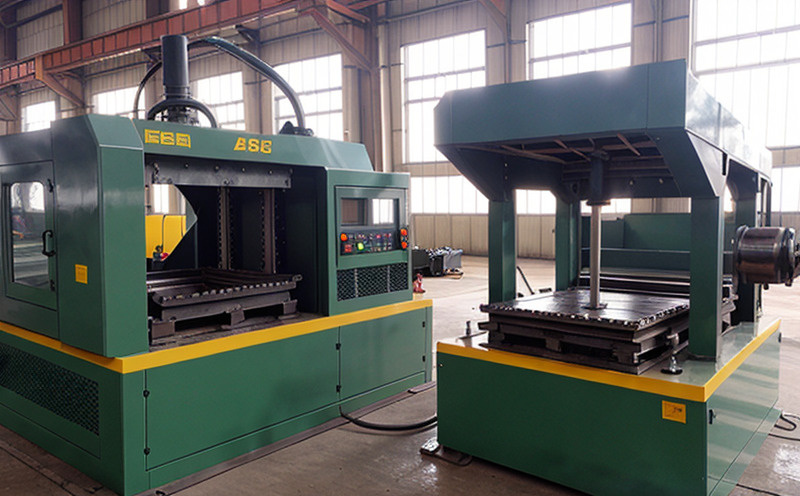ASTM E517 Plastic Strain Ratio Testing of Sheet Metals
The ASTM E517 standard specifies the procedures for determining the plastic strain ratio (K) of sheet metals using a uniaxial tensile test. This testing method is crucial in assessing the material's ability to undergo significant deformation before fracture, which is particularly relevant in industrial manufacturing and processing sectors where sheet metals are subjected to various forming processes such as forging, stamping, and rolling.
Understanding K values helps manufacturers optimize their production processes by ensuring that materials can withstand expected stresses without failure. The plastic strain ratio is a key parameter used in designing components for safety and durability. In industries like automotive and aerospace, where lightweight yet strong materials are essential, ASTM E517 testing provides critical insights into material behavior under stress.
The test involves preparing a specimen from the sheet metal of interest, typically cut to standard dimensions. The specimen is then subjected to uniaxial tensile loading at a controlled rate until failure occurs. During this process, strain gauges are attached to measure both normal and shear strains within the material. Data collected during testing includes peak load, total elongation, and the plastic strain ratio.
ASTM E517 provides detailed instructions on specimen preparation, test setup, data acquisition, and analysis. Compliance with these standards ensures accurate results that are reproducible across different laboratories. This consistency is vital for quality control and regulatory compliance in manufacturing environments.
The significance of ASTM E517 extends beyond material testing into broader industrial practices. By understanding the plastic strain ratio, engineers can predict how materials will perform under specific conditions, leading to improved product design and reduced risk of failures during production or use.
| Step | Action | Details |
|---|---|---|
| 1 | Prepare specimen | Cut sheet metal to standard dimensions, ensuring flatness and absence of defects. |
| 2 | Attach strain gauges | Position gauges on the specimen to measure normal and shear strains accurately. |
| 3 | Apply uniaxial tensile load | Load specimen at a constant rate until failure occurs, recording all relevant data. |
| 4 | Analyze results | Determine the plastic strain ratio and compare it against accepted values for the material. |
The ASTM E517 standard is widely recognized in industries where high-strength, lightweight materials are required. Its application ensures that products meet stringent quality standards while maintaining safety and performance requirements.
Applied Standards
The ASTM E517 plastic strain ratio testing adheres strictly to the guidelines set out by ASTM International (formerly American Society for Testing and Materials). This standard provides comprehensive protocols for conducting uniaxial tensile tests on sheet metals. Compliance with these standards guarantees that test results are reliable, consistent, and comparable across different laboratories.
The ASTM E517 methodology focuses on the following aspects:
- Specimen preparation
- Strain gauge placement
- Tensile testing procedure
- Data analysis and interpretation
By adhering to these standards, laboratories ensure that their test results are valid and meet the highest industry benchmarks. This is particularly important in sectors such as automotive manufacturing, where material performance directly impacts vehicle safety and durability.
ASTM E517 is just one of many standards used in industrial testing. Other relevant standards include ASTM E8, which deals with tensile testing of metallic materials, and ISO 6892-1, covering general requirements for the mechanical testing of metals. Together, these standards form a robust framework for ensuring material quality and reliability across various industries.
Environmental and Sustainability Contributions
The ASTM E517 plastic strain ratio test plays an essential role in promoting sustainability within industrial manufacturing processes by providing critical data that helps minimize waste and optimize resource use. By accurately determining the plastic strain ratio, manufacturers can better predict material behavior under stress, leading to more efficient design and production practices.
Understanding K values allows engineers to select materials that offer optimal balance between strength and ductility, reducing unnecessary overdesign and minimizing scrap rates during manufacturing processes. This not only enhances product performance but also contributes positively to environmental sustainability goals by conserving resources and energy.
In addition to improving material selection, ASTM E517 testing supports broader industrial initiatives aimed at reducing environmental impact. For instance, in the automotive industry, accurate K values contribute to lighter vehicles that require less fuel and emit fewer greenhouse gases. Similarly, in aerospace applications, optimized materials lead to more efficient aircraft designs with reduced carbon footprints.
Moreover, ASTM E517 testing contributes to lifecycle assessments by providing insights into material durability and recyclability. By ensuring that materials can withstand expected stresses without failure during their useful lives, manufacturers promote circular economy principles through extended product lifecycles and easier recycling processes at end-of-life stages.
Use Cases and Application Examples
- Automotive Industry: Ensuring that sheet metals used in car bodies can withstand crash impacts without failure.
- Aerospace Manufacturing: Verifying the durability of lightweight materials for aircraft structures under extreme conditions.
- Furniture Production: Assessing the strength and flexibility of wood composites or metal alloys used in furniture frames.
- Bicycle Fabrication: Evaluating the resilience of frame materials to ensure long-lasting performance.
ASTM E517 plastic strain ratio testing is applicable across various sectors where sheet metals are involved. In each case, understanding K values helps optimize material selection and process design for enhanced product quality and safety.
| Use Case | Description |
|---|---|
| Automotive Crash Testing | Determining the plastic strain ratio of steel used in car body panels to ensure they can absorb impact energy safely. |
| Bicycle Frame Manufacturing | Evaluating aluminum alloys for their ability to withstand torsional and tensile forces during cycling. |
| Aerospace Component Design | Assessing titanium alloys in aircraft components for their fatigue resistance under cyclic loading conditions. |
| Furniture Frame Construction | Testing wood fiber composites to ensure they meet durability standards for long-term use. |





